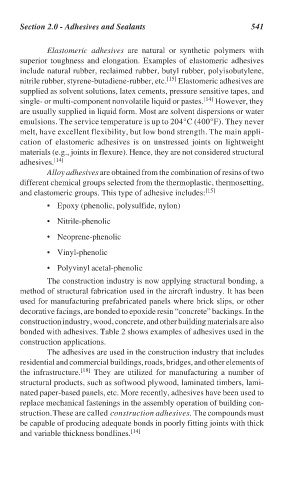Page 571 - Handbook of Thermal Analysis of Construction Materials
P. 571
Section 2.0 - Adhesives and Sealants 541
Elastomeric adhesives are natural or synthetic polymers with
superior toughness and elongation. Examples of elastomeric adhesives
include natural rubber, reclaimed rubber, butyl rubber, polyisobutylene,
nitrile rubber, styrene-butadiene-rubber, etc. [15] Elastomeric adhesives are
supplied as solvent solutions, latex cements, pressure sensitive tapes, and
single- or multi-component nonvolatile liquid or pastes. [14] However, they
are usually supplied in liquid form. Most are solvent dispersions or water
emulsions. The service temperature is up to 204°C (400°F). They never
melt, have excellent flexibility, but low bond strength. The main appli-
cation of elastomeric adhesives is on unstressed joints on lightweight
materials (e.g., joints in flexure). Hence, they are not considered structural
adhesives. [14]
Alloy adhesives are obtained from the combination of resins of two
different chemical groups selected from the thermoplastic, thermosetting,
and elastomeric groups. This type of adhesive includes: [15]
• Epoxy (phenolic, polysulfide, nylon)
• Nitrile-phenolic
• Neoprene-phenolic
• Vinyl-phenolic
• Polyvinyl acetal-phenolic
The construction industry is now applying structural bonding, a
method of structural fabrication used in the aircraft industry. It has been
used for manufacturing prefabricated panels where brick slips, or other
decorative facings, are bonded to epoxide resin “concrete” backings. In the
construction industry, wood, concrete, and other building materials are also
bonded with adhesives. Table 2 shows examples of adhesives used in the
construction applications.
The adhesives are used in the construction industry that includes
residential and commercial buildings, roads, bridges, and other elements of
the infrastructure. [18] They are utilized for manufacturing a number of
structural products, such as softwood plywood, laminated timbers, lami-
nated paper-based panels, etc. More recently, adhesives have been used to
replace mechanical fastenings in the assembly operation of building con-
struction. These are called construction adhesives. The compounds must
be capable of producing adequate bonds in poorly fitting joints with thick
and variable thickness bondlines. [14]

